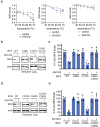This is a preprint.
Covalent Degraders of Immune Regulatory Transcription Factors IRF8 and IRF5
- PMID: 40766490
- PMCID: PMC12324457
- DOI: 10.1101/2025.08.03.668300
Covalent Degraders of Immune Regulatory Transcription Factors IRF8 and IRF5
Abstract
Transcription factors are among the most challenging targets for drug discovery due to their lack of classical binding pockets and high degree of intrinsic disorder, despite the therapeutic importance of many of these proteins. IRF5 and IRF8 are key transcriptional regulators of innate immune signaling that orchestrate pro-inflammatory gene expression programs in response to stimuli such as toll-like receptor activation, making them central players in autoimmune and inflammatory diseases. Despite their therapeutic interest, direct targeting of IRF5 and IRF8 has remained challenging. Here, we screened a library of cysteine-reactive covalent ligands to identify hits that could degrade IRF5. We identified acrylamide EN1033 as the top hit, which not only led to IRF5 loss in a proteasome-dependent manner but also bound directly and covalently to the IRF5 protein, inhibiting IRF5-specific transcriptional activity in a macrophage cell line. Upon further analysis, however, we found that EN1033 not only engaged and degraded IRF5 but also more robustly and rapidly engaged and degraded a related inflammatory transcription factor, IRF8. We further demonstrated that EN1033 destabilized and degraded IRF5 and IRF8 by covalently targeting C28 and C223, respectively, as evidenced by the attenuation of their degradation through mutagenesis of these cysteines. We also found that IRF8 loss led to the downregulation and inhibition of IRF5 activity, suggesting a crosstalk between these two transcription factors, which are both targeted by EN1033. Overall, we identify an early-stage pathfinder molecule that covalently targets IRF8 and IRF5, thereby degrading these transcription factors and inhibiting their pro-inflammatory transcriptional activity.
Keywords: IRF5; IRF8; activity-based protein profiling; chemoproteomics; covalent; cysteine; monovalent degraders; targeted protein degradation.
Conflict of interest statement
Competing Financial Interests Statement HC, LYC, CL, MLA, JG, SS, NSA, SK are Octant Bio employees. DKN is a co-founder, shareholder, and member of the scientific advisory board for Frontier Medicines and Zenith. DKN is a member of the board of directors for Vicinitas Therapeutics. DKN is also a member of the scientific advisory boards of The Mark Foundation for Cancer Research, American Association for Cancer Research, Photys Therapeutics, Oerth Bio, Apertor Pharmaceuticals, Axiom Therapeutics, and Ten30 Biosciences. DKN is also an Investment Advisory Partner for a16z Bio, an Advisory Board member for Droia Ventures, and an iPartner for The Column Group.
Figures





References
-
- Henley M. J. & Koehler A. N. Advances in targeting ‘undruggable’ transcription factors with small molecules. Nat. Rev. Drug Discov. 20, 669–688 (2021). - PubMed
-
- Taniguchi T., Ogasawara K., Takaoka A. & Tanaka N. IRF family of transcription factors as regulators of host defense. Annu. Rev. Immunol. 19, 623–655 (2001). - PubMed
Publication types
Grants and funding
LinkOut - more resources
Full Text Sources
